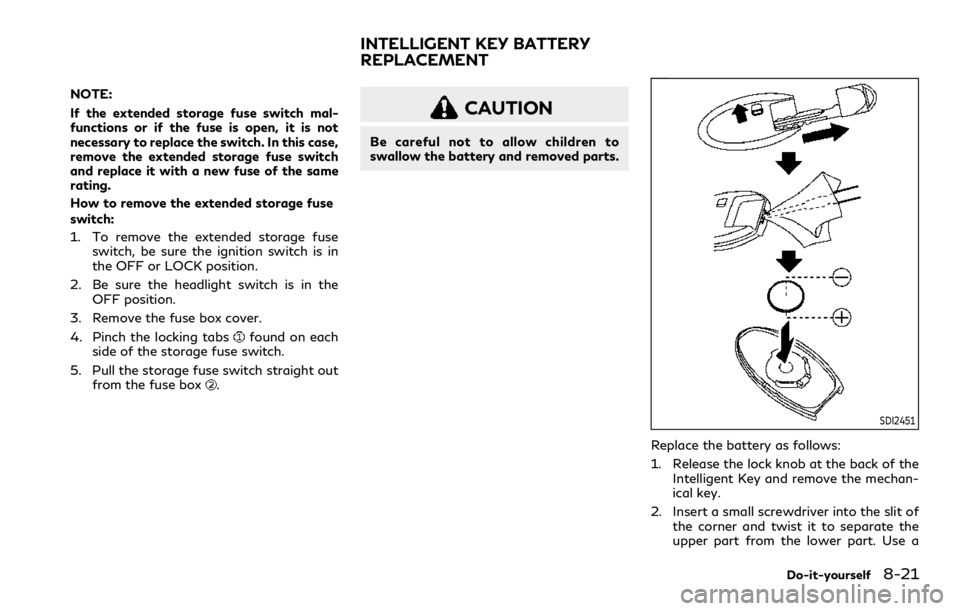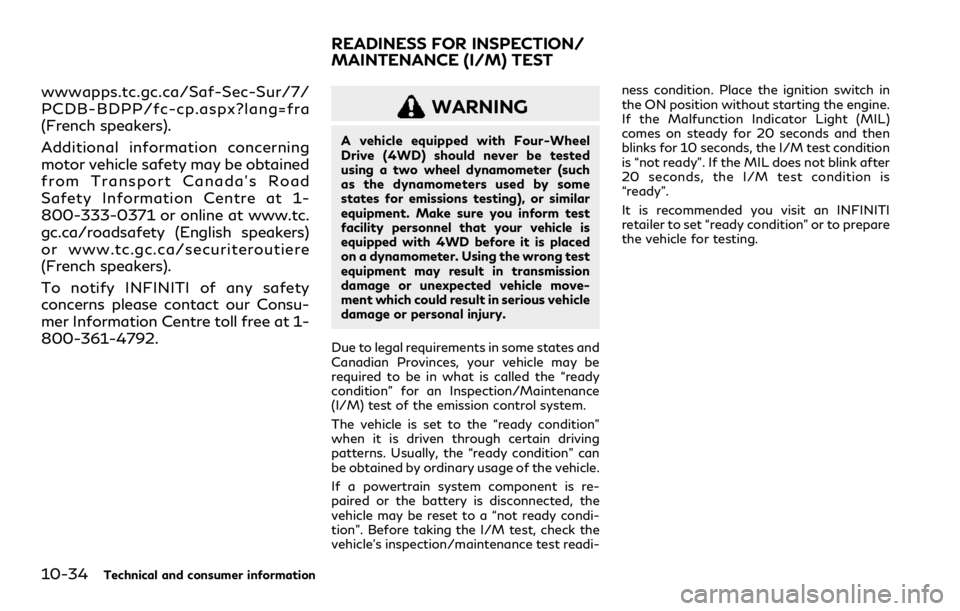battery INFINITI QX80 2021 Repair Manual
[x] Cancel search | Manufacturer: INFINITI, Model Year: 2021, Model line: QX80, Model: INFINITI QX80 2021Pages: 529, PDF Size: 2.05 MB
Page 444 of 529

NOTE:
If the extended storage fuse switch mal-
functions or if the fuse is open, it is not
necessary to replace the switch. In this case,
remove the extended storage fuse switch
and replace it with a new fuse of the same
rating.
How to remove the extended storage fuse
switch:
1. To remove the extended storage fuseswitch, be sure the ignition switch is in
the OFF or LOCK position.
2. Be sure the headlight switch is in the OFF position.
3. Remove the fuse box cover.
4. Pinch the locking tabs
found on each
side of the storage fuse switch.
5. Pull the storage fuse switch straight out from the fuse box
.
CAUTION
Be careful not to allow children to
swallow the battery and removed parts.
SDI2451
Replace the battery as follows:
1. Release the lock knob at the back of theIntelligent Key and remove the mechan-
ical key.
2. Insert a small screwdriver into the slit of the corner and twist it to separate the
upper part from the lower part. Use a
Do-it-yourself8-21
INTELLIGENT KEY BATTERY
REPLACEMENT
Page 445 of 529

8-22Do-it-yourself
cloth to protect the casing.
3. Replace the battery with a new one. Recommended battery: CR2025 or
equivalent.
.Do not touch the internal circuit andelectric terminals as it could cause a
malfunction.
.Hold the battery by the edges. Hold-
ing the battery across the contact
points will seriously deplete the sto-
rage capacity.
.Make sure that the + side faces thebottom of the case.
SDI2452
4. Align the tips of the upper and lower
parts, and then push them together
until it is securely closed.
5. Push the buttons two or three times to check its operation.
It is recommended you visit an INFINITI
retailer if you need any assistance for
replacement.
FCC Notice:
For USA:
This device complies with Part 15 of the
FCC Rules. Operation is subject to the
following two conditions: (1) This device
may not cause harmful interference, and (2)
this device must accept any interference received, including interference that may
cause undesired operation.
Note: Changes or modifications not ex-
pressly approved by the party responsible
for compliance could void the user’s author-
ity to operate the equipment.
For Canada:
This device complies with Industry Canada
licence-exempt RSS standard(s). Operation
is subject to the following two conditions:
(1) this device may not cause interference,
and (2) this device must accept any inter-
ference, including interference that may
cause undesired operation of the device.
Page 465 of 529

9-4Maintenance and schedules
equipped) hold securely in all latched posi-
tions.
Steering wheel:Check for changes in the
steering conditions, such as excessive free
play, hard steering or strange noises.
Warning lights and chimes: Make sure that
all warning lights and chimes are operating
properly.
Windshield defroster: Check that the air
comes out of the defroster outlets properly
and in sufficient quantity when operating
the heater or air conditioner.
Windshield wiper and washer*: Check that
the wipers and washer operate properly and
that the wipers do not streak.
Under the hood and vehicle
The maintenance items listed here should be
checked periodically (for example, each time
you check the engine oil or refuel).
Battery*: Check the fluid level in each cell. It
should be between the MAX and MIN lines.
Vehicles operated in high temperatures or
under severe condition require frequent
checks of the battery fluid level.
NOTE:
Care should be taken to avoid situations
that can lead to potential battery discharge
and potential no-start conditions such as: 1.
Installation or extended use of electro-
nic accessories that consume battery
power when the engine is not running
(Phone chargers, GPS, DVD players,
etc.)
2. Vehicle is not driven regularly and/or
only driven short distances.
In these cases, the battery may need to be
charged to maintain battery health.
Brake fluid level*: Make sure that the brake
fluid level is between the MAX and MIN lines
on the reservoir.
Engine coolant level*: Check the coolant
level when the engine is cold.
Engine drive belt*: Make sure that no belt is
frayed, worn, cracked or oily.
Engine oil level*: Check the level after
parking the vehicle on a level spot and
turning off the engine. Wait more than 15
minutes for the oil to drain back into the oil
pan.
Exhaust system: Make sure there are no
loose supports, cracks or holes. If the sound
of the exhaust seems unusual or there is a
smell of exhaust fumes, immediately have
the exhaust system inspected. It is recom-
mended you visit an INFINITI retailer for this
service. (See “Precautions when starting and
driving” (P.5-4) for exhaust gas (carbon
monoxide).) Fluid leaks:
Check under the vehicle for fuel,
oil, water or other fluid leaks after the
vehicle has been parked for a while. Water
dripping from the air conditioner after use is
normal. If you should notice any leaks or if
gasoline fumes are evident, check for the
cause and have it corrected immediately.
Power steering fluid level* and lines: Check
the level when the fluid is cold, with the
engine off. Check the lines for proper
attachment, leaks, cracks, etc.
Radiator and hoses: Check the front of the
radiator and clean off any dirt, insects,
leaves, etc., that may have accumulated.
Make sure the hoses have no cracks, defor-
mation, rot or loose connections.
Underbody: The underbody is frequently
exposed to corrosive substances such as
those used on icy roads or to control dust. It
is very important to remove these sub-
stances, otherwise rust will form on the
floor pan, frame, fuel lines and around the
exhaust system. At the end of winter, the
underbody should be thoroughly flushed
with plain water, being careful to clean
those areas where mud and dirt may accu-
mulate. For additional information, see
“Cleaning exterior” (P.7-2).
Windshield washer fluid*: Check that there
is adequate fluid in the reservoir.
Page 470 of 529

22,500 Miles/18 Months/36,000
Km
Standard maintenance:.Inspect Intelligent key battery.Replace engine oil and filter.Perform tire rotation
Severe maintenance:
Not Applicable. Proceed to next interval.
25,000 Miles/30 Months/40,000
Km
Standard maintenance:
Not Applicable. Proceed to next interval.
Severe maintenance:
.Inspect brake pads and rotors.Inspect steering gear and linkage.Inspect axle and suspension parts.Inspect propeller shaft (4WD models).Inspect drive shaft boots (4WD models).Inspect exhaust system.Replace engine oil and filter
30,000 Miles/24 Months/48,000
Km
Standard maintenance:.Inspect brake lines and cables.Inspect brake pads and rotors.Inspect fuel tank vapor vent system hoses.Inspect fuel lines/connections.Inspect exhaust system.Inspect steering gear and linkage.Inspect axle and suspension parts.Replace differential gear oil.Inspect propeller shaft (4WD models).Inspect transfer case oil (4WD models).Inspect drive shaft boots (4WD models).Replace engine oil and filter.Replace engine air filter (1).Replace brake fluid.Replace in-cabin microfilter.Perform tire rotation.Lubricate propeller shaft grease (4WD models)
Severe maintenance:
Not Applicable. Proceed to next interval.
(1) If operating mainly in dusty conditions, more
frequent maintenance may be required.
Maintenance and schedules9-9
Page 472 of 529

40,000 Miles/48 Months/64,000
Km
Standard maintenance:
Not Applicable. Proceed to next interval.
Severe maintenance:
.Inspect brake pads and rotors.Inspect steering gear and linkage.Inspect axle and suspension parts.Inspect propeller shaft (4WD models).Inspect drive shaft boots (4WD models).Inspect exhaust system.Replace engine oil and filter.Replace brake fluid.Replace differential gear oil.Replace transfer case oil (4WD models)
45,000 Miles/36 Months/72,000
Km
Standard maintenance:.Inspect brake lines and cables.Inspect brake pads and rotors.Inspect propeller shaft (4WD models).Replace differential gear oil.Inspect transfer case oil (4WD models).Inspect drive shaft boots (4WD models).Replace engine oil and filter.Replace in-cabin microfilter.Replace Intelligent Key battery.Perform tire rotation.Lubricate propeller shaft grease (4WD models)
Severe maintenance:
Not Applicable. Proceed to next interval.
45,000 Miles/54 Months/72,000
Km
Standard maintenance:
Not Applicable. Proceed to next interval.
Severe maintenance:
.Inspect brake pads and rotors.Inspect steering gear and linkage.Inspect axle and suspension parts.Inspect propeller shaft (4WD models).Inspect drive shaft boots (4WD models).Inspect exhaust system.Replace engine oil and filter
Maintenance and schedules9-11
Page 475 of 529

9-14Maintenance and schedules
67,500 Miles/54 Months/108,000
Km
Standard maintenance:.Replace engine oil and filter.Replace Intelligent Key battery.Perform tire rotation
Severe maintenance:
Not Applicable. Proceed to next interval.
70,000 Miles/84 Months/112,000
Km
Standard maintenance:
Not Applicable. Proceed to next interval.
Severe maintenance:
.Inspect brake pads and rotors.Inspect steering gear and linkage.Inspect axle and suspension parts.Inspect propeller shaft (4WD models).Inspect drive shaft boots (4WD models).Inspect exhaust system.Replace engine oil and filter.Replace brake fluid
75,000 Miles/60 Months/120,000
Km
Standard maintenance:.Inspect brake lines and cables.Inspect brake pads and rotors.Inspect engine drive belts.Inspect propeller shaft (4WD models).Replace differential gear oil.Inspect drive shaft boots (4WD models).Inspect transfer case oil (4WD models).Replace engine oil and filter.Replace in-cabin microfilter.Perform tire rotation.Lubricate propeller shaft grease (4WD models)
Severe maintenance:
Not Applicable. Proceed to next interval.
Page 477 of 529

9-16Maintenance and schedules
85,000 Miles/102 Months/
136,000 Km
Standard maintenance:
Not Applicable. Proceed to next interval.
Severe maintenance:
.Inspect brake pads and rotors.Inspect steering gear and linkage.Inspect axle and suspension parts.Inspect propeller shaft (4WD models).Inspect drive shaft boots (4WD models).Inspect exhaust system.Replace engine oil and filter
90,000 Miles/72 Months/144,000
Km
Standard maintenance:.Inspect brake lines and cables.Inspect brake pads and rotors.Inspect engine drive belts.Inspect fuel tank vapor vent system hoses.Inspect fuel lines/connections.Inspect exhaust system.Inspect propeller shaft (4WD models).Inspect steering gear and linkage.Inspect axle and suspension parts.Replace differential gear oil.Inspect transfer case oil (4WD models).Inspect drive shaft boots (4WD models).Replace engine air filter (1).Replace brake fluid.Replace engine oil and filter.Replace in-cabin microfilter.Replace Intelligent Key battery.Perform tire rotation.Lubricate propeller shaft grease (4WD models)
Severe maintenance:
Not Applicable. Proceed to next interval.
(1) If operating mainly in dusty conditions, more
frequent maintenance may be required.
90,000 Miles/108 Months/
144,000 Km
Standard maintenance:
Not Applicable. Proceed to next interval.
Severe maintenance:
.Inspect brake pads and rotors.Inspect steering gear and linkage.Inspect axle and suspension parts.Inspect propeller shaft (4WD models).Inspect drive shaft boots (4WD models).Inspect exhaust system.Replace engine oil and filter.Replace brake fluid
Page 480 of 529

112,500 Miles/90 Months/
180,000 Km
Standard maintenance:.Replace engine oil and filter.Replace Intelligent Key battery.Perform tire rotation
Severe maintenance:
Not Applicable. Proceed to next interval.
115,000 Miles/138 Months/
184,000 Km
Standard maintenance:
Not Applicable. Proceed to next interval.
Severe maintenance:
.Inspect brake pads and rotors.Inspect steering gear and linkage.Inspect axle and suspension parts.Inspect propeller shaft (4WD models).Inspect drive shaft boots (4WD models).Inspect exhaust system.Replace engine oil and filter
120,000 Miles/96 Months/
192,000 Km
Standard maintenance:.Inspect brake lines and cables.Inspect brake pads and rotors.Inspect engine drive belts.Inspect fuel tank vapor vent system hoses.Inspect fuel lines/connections.Inspect exhaust system.Inspect propeller shaft (4WD models).Inspect steering gear and linkage.Inspect axle and suspension parts.Replace differential gear oil.Inspect transfer case oil (4WD models).Inspect drive shaft boots (4WD models).Replace engine air filter (1).Replace brake fluid.Replace engine oil and filter.Replace in-cabin microfilter.Perform tire rotation.Lubricate propeller shaft grease (4WD models)
Severe maintenance:
Not Applicable. Proceed to next interval.
(1) If operating mainly in dusty conditions, more
frequent maintenance may be required.
Maintenance and schedules9-19
Page 508 of 529

STI0745
Trailer lights
Your vehicle is equipped with a towing
package, which also includes the 7-pin trailer
harness connector located under the trailer
hitch cover on the rear bumper.
CAUTION
.When splicing into the vehicle elec-
trical system, a commercially avail-
able power-type module/converter
must be used to provide power for
all trailer lighting. This unit uses the
vehicle battery as a direct power
source for all trailer lights while using the vehicle tail light, stoplight and
turn signal circuits as a signal source.
The module/converter must draw no
more than 15 milliamps from the stop
and tail lamp circuits. Using a mod-
ule/converter that exceeds these
power requirements may damage
the vehicle’s electrical system. See a
reputable trailer retailer to obtain the
proper equipment and to have it
installed.
. Do not connect electrical devices that
draw more than 40 amps to the
vehicle. The fusible link may melt.
Trailer lights should comply with federal
and/or local regulations. For assistance in
hooking up trailer lights, contact an INFINITI
retailer or reputable trailer retailer.
Trailer brakes
When towing a trailer load of 3,500 lbs.
(1,587 kg) or more, trailers with a brake
system MUST be used. However, most
states require a separate braking system on
trailers with a loaded weight above a
specific amount. Make sure the trailer meets
the local regulations and the regulations
where you plan to tow.
Several types of braking systems are avail-
able. Surge Brakes -
The surge brake actuator is
mounted on the trailer tongue with a
hydraulic line running to each trailer wheel.
Surge brakes are activated by the trailer
pushing against the hitch ball when the tow
vehicle is braking. Hydraulic surge brakes are
common on rental trailers and some boat
trailers. In this type of system, there is no
hydraulic or electric connection for brake
operation between the tow vehicle and the
trailer.
Electric Trailer Brakes - Electric braking
systems are activated by an electronic signal
sent from a trailer brake controller (special
brake sensing module).
Have a professional supplier of towing
equipment make sure the trailer brakes are
properly installed and demonstrate proper
brake function testing.WARNING
Never connect a trailer brake system
directly to the vehicle brake system.
Pre-towing tips
. Be certain your vehicle maintains a level
position when a loaded or unloaded
trailer is hitched. Do not drive the vehicle
if it has an abnormal nose-up or nose-
Technical and consumer information10-27
Page 515 of 529

10-34Technical and consumer information
wwwapps.tc.gc.ca/Saf-Sec-Sur/7/
PCDB-BDPP/fc-cp.aspx?lang=fra
(French speakers).
Additional information concerning
motor vehicle safety may be obtained
from Transport Canada’s Road
Safety Information Centre at 1-
800-333-0371 or online at www.tc.
gc.ca/roadsafety (English speakers)
or www.tc.gc.ca/securiteroutiere
(French speakers).
To notify INFINITI of any safety
concerns please contact our Consu-
mer Information Centre toll free at 1-
800-361-4792.
WARNING
A vehicle equipped with Four-Wheel
Drive (4WD) should never be tested
using a two wheel dynamometer (such
as the dynamometers used by some
states for emissions testing), or similar
equipment. Make sure you inform test
facility personnel that your vehicle is
equipped with 4WD before it is placed
on a dynamometer. Using the wrong test
equipment may result in transmission
damage or unexpected vehicle move-
ment which could result in serious vehicle
damage or personal injury.
Due to legal requirements in some states and
Canadian Provinces, your vehicle may be
required to be in what is called the “ready
condition” for an Inspection/Maintenance
(I/M) test of the emission control system.
The vehicle is set to the “ready condition”
when it is driven through certain driving
patterns. Usually, the “ready condition” can
be obtained by ordinary usage of the vehicle.
If a powertrain system component is re-
paired or the battery is disconnected, the
vehicle may be reset to a “not ready condi-
tion”. Before taking the I/M test, check the
vehicle’s inspection/maintenance test readi- ness condition. Place the ignition switch in
the ON position without starting the engine.
If the Malfunction Indicator Light (MIL)
comes on steady for 20 seconds and then
blinks for 10 seconds, the I/M test condition
is “not ready”. If the MIL does not blink after
20 seconds, the I/M test condition is
“ready”.
It is recommended you visit an INFINITI
retailer to set “ready condition” or to prepare
the vehicle for testing.
READINESS FOR INSPECTION/
MAINTENANCE (I/M) TEST